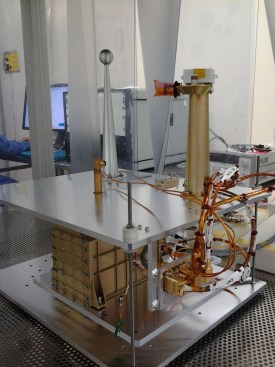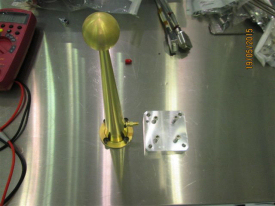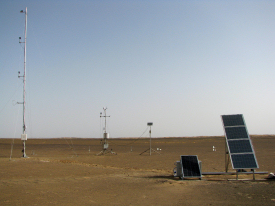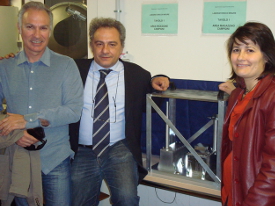Delivering DREAMS: An interview with Francesca Esposito, Principal Investigator of DREAMS
The first mission of ESA's ExoMars programme, which is scheduled to arrive at Mars in October 2016, consists of the Trace Gas Orbiter plus Schiaparelli, an entry, descent and landing demonstrator module.
The scientific payload on Schiaparelli includes the DREAMS (Dust characterisation, Risk assessment, and Environment Analyser on the Martian Surface) package.
DREAMS consists of a suite of sensors to measure the local wind speed and direction (MetWind), humidity (DREAMS-H), pressure (DREAMS-P), atmospheric temperature close to the surface (MarsTem), the transparency of the atmosphere (Solar Irradiance Sensor, SIS), and atmospheric electrification (Atmospheric Radiation and Electricity Sensor; MicroARES).
The Principal Investigator for DREAMS is Francesca Esposito from INAF - Osservatorio Astronomico di Capodimonte, Naples, Italy. We asked Francesca to tell us more about the instrument that the DREAMS team has created.
What is DREAMS?
DREAMS is a small meteorological station that will measure local weather conditions at the landing site, such as temperature, humidity, pressure, dust opacity, wind speed and wind direction. It will also perform measurements of the electrical properties of the Martian atmosphere, the first time this has ever been done.
How will DREAMS operate?
 |
| DREAMS flight model. Credit: ASI & DREAMS Team (INAF, Napoli, Italy; CISAS, Padova, Italy; LATMOS, France; ESA-ESTEC, Noordwijk; Oxford University, United Kingdom; FMI, Finland; INTA, Spain) |
DREAMS will perform its measurements after Schiaparelli has landed on Mars. Following a wake-up command from the lander's electronics, it will start to operate autonomously for 2-4 sols (martian days), until its battery runs out. Unfortunately, due to the limited energy available, DREAMS cannot work continuously during the Martian day. Instead, it will operate in 31 predefined sampling windows, lasting a total of about 6 hours during each sol.
What are the science objectives for DREAMS?
Schiaparelli will land on Mars during the season when dust storms are most common, so DREAMS will have the chance to characterise the Martian environment when the atmosphere is loaded with dust. All of the DREAMS sensors have been designed to survive these conditions on Mars.
In addition to meteorological measurements, DREAMS will measure opacity in the atmosphere due to dust at the landing site and the effects of dust on atmospheric layers.
Another important objective is to provide data on the dangers posed by dust to help engineers quantify hazards for equipment and future human explorers. The data will include the velocity of windblown dust, electrostatic charging, existence of electrical discharges, electromagnetic noise that could potentially affect communications, and the intensity of ultraviolet (UV) radiation.
 |
|
The MicroARES sensor will measure atmospheric electrification. Credit: LATMOS, France; ESA-ESTEC, Noordwijk; DREAMS Team |
I'm particularly excited about the first ever investigation of atmospheric electrical phenomena at Mars. A global atmospheric electrical circuit is thought to exist on Mars, between the surface and the ionosphere. Impact charging through collisions between the surface and dust particles moved by the wind, or between dust particles themselves, is expected to be the dominant charging mechanism.
Intense electrical fields, possibly capable of producing atmospheric electrical breakdown, are expected during dust storms and in the vicinity of dust devils. Moreover, dust and sand electrical charging can have an important role in the process of lifting dust from the surface, influencing the evolution of dust storms on Mars.
This charging process has been also theorised to have an impact on the production of atmospheric molecules that may be responsible for the scavenging of organic materials from the surface of Mars, an important factor when considering the possibility of life on Mars and the potential preservation of molecular biosignatures over long periods.
So, the results that DREAMS will collect will help to shed light on several important key issues in Martian science and will inform the operations of future missions, including the ExoMars 2018 rover.
How did DREAMS come about?
It was born from an initial proposal for Schiaparelli to carry a miniaturised version of the Italian instruments that had been previously selected for a payload on Humboldt, a lander planned to be part of the ExoMars mission that was cancelled in 2009.
We invited other European institutes to join us in the project, and in this way we gathered together people with experiences matured in Europe under similar conditions: many of these people had worked on advanced studies performed for martian space missions that for different reasons had not reached Mars yet.
We organised several international meetings in Naples between the end of 2010 and early 2011 to select the best candidate sensors to be presented as an autonomous suite for the ESA call for payload on what was to become the Schiaparelli platform. The original proposal included 11 sensors including a camera. Only six of these were accepted by ESA, mostly based on the hardware maturity.
The acronym DREAMS in part reflects the dreams of reaching Mars of all the team members. At the time when we proposed it, we had all worked hard for many years to prepare excellent martian instruments that were ready but that never seemed to have an opportunity to fly due to the cancellation of the missions they were supposed be on – now this dream is close.
How do you feel now that the instrument has been handed over?
It really has not yet sunk in, as there is still a lot of work in front of us. We 'hit the ground running' with this project and we are still running! Our payload proposal was selected in June 2011 and we have produced five models (including the flight one, which is actually mounted on Schiaparelli) in less than four years. A very great effort was made by all the team to achieve this goal, with the constant supervision of ASI, the Italian Space Agency, and ESA.
We are very proud of what we have been able to achieve and look forward to seeing our DREAMS on Mars.
How have you been preparing to interpret DREAMS data?
 |
| Measurement station, Western Sahara, 2014. Credit: INAF, Napoli, Italy & Italian Space Agency (ASI) |
In order to study in detail the effect of electrical charging during dusty events – dust storms, dust devils, blowing sand and dust – the team performed several campaigns in the Western Sahara desert during 2013 and 2014. The measurement site was chosen for its similarity to Mars.
We deployed instruments similar to the DREAMS sensors and collected a lot of atmospheric and environmental data. Our focus was on the processes responsible for lifting dust into the air and the relative feedback with the electrical properties of the atmosphere. The unique results we acquired will help us to interpret similar phenomena on Mars.
Who are the DREAMS team?
 |
|
Raffaele Mugnuolo (ASI Programme Manager for ExoMars), Stefano Debei (DREAMS Co-Principal Investigator) and Francesca Esposito (DREAMS Principal Investigator). Credit: DREAMS Team |
The DREAMS team includes more than 50 researchers. The consortium comprises various European and US institutions, with myself as the Principal Investigator, and Stefano Debei from CISAS – Università di Padova in Italy as the Co-Principal Investigator.
The DREAMS management includes Carlo Bettanini (CISAS) as the Project Manager, Cesare Molfese (INAF - Napoli) as the Technical Manager, Pietro Schipani (INAF - Napoli) as the Data Manager, and Alessio Aboudan (CISAS) as the Electric and Software Engineer.
Other European institutes or organisations that were involved in hardware design and development include CNRS-LATMOS (France); ESA-ESTEC; Oxford University (UK); Finnish Meteorological Institute (FMI), Helsinki (Finland); and INTA (Spain). The Italian Space Agency (ASI) is the lead funding agency, with Raffaele Mugnuolo as the Programme Manager.
The overall system activity was carried out by CISAS, coordinated by Stefano Debei. CISAS also developed the MarsTem thermometer (Lead Co-Investigator: Giacomo Colombatti) and the Central Electronics Unit, with TEMIS s.r.l. as the industrial partner.
The MicroARES sensor was designed and developed by LATMOS and funded by CNES and ESA. The Lead Co-Investigator is Franck Montmessin (LATMOS), and the ESA scientific responsible is Olivier Witasse (ESA/ESTEC). MetWind was designed by Oxford University and developed with CISAS; the Lead Co-Investigator is Colin Wilson (Oxford University). DREAMS-P and DREAMS-H were designed and developed by FMI; the Lead Co-Investigator for both of these is Ari-Matti Harri (FMI). SIS was designed and realised by INTA; the Lead Co-Investigator is Ignacio Arruego Rodríguez (INTA).









